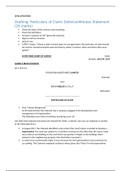CIVIL LITIGATION
Drafting- Particulars of Claim/ Defence/Witness Statement
(20 marks)
Check the dates of the contract and everything
Check the definitions
Inclusive/ exclusive of VAT (generally inclusive)
Figures and loss amounts
duty of care
16PD7.4 states: “where a claim is based upon an oral agreement, the particulars of claim should
set out the contractual words used and state by whom, to whom, when and where they were
spoken”
IN THE HIGH COURT OF JUSTICE Claim
Number: 2019 HC 1234
QUEEN’S BENCH DIVISION
BETWEEN
RITCHISONS INVESTMENTS LIMITED
Claimant
- and -
BONO WELLER & CO LLP
Defendant
_______________________________
PARTICULARS OF CLAIM
_______________________________
1. Para 1 always Background
- At all material times the Claimant was a company engaged in the development and
management of a hypermarket.
- The Defendant was a firm of solicitors practising as an LLP.
[On [date] the Claimant instructed and retained Mr Smith, a solicitor, who was an employee or partner
of the Defendant firm.]
2. In August 2017, the Claimant identified a site in Kent (the 'Land') where it wished to develop a
hypermarket. The Land was subject to a restrictive covenant to the effect that the owner could
not construct any building on the Land which was greater in height to the buildings which
existed on the neighbouring property (the 'Restrictive Covenant').
3. In order to be commercially viable, it was necessary for the hypermarket to have provision for
car parking. The Claimant employed architects whose plans (the 'Plans') for the hypermarket
, were for a two storey building, the second storey of which was to be a car park. The height of
the hypermarket in accordance with the Plans was below the top level of the chimneys on the
buildings which existed on the neighbouring property but above the ridge-line of those
buildings.
4. On 5 October 2017, the Claimant (through its Operations Director, Francis Vollbehr) sent a letter
of instruction to Mr John Weller (‘Mr Weller’), a solicitor who was a partner in the Defendant, to
act on the potential purchase of the Land and, in this connection, to advise whether the Plans
would be in breach of the Restrictive Covenant. Mr Weller duly accepted the Claimant’s
instructions on behalf of the Defendant by a letter dated 6 October 2017 (the ‘Retainer’). A copy
of the Retainer is attached to these Particulars of Claim.
5. The Defendant was instructed on the basis that, at all material times, Mr Weller held himself out
to be an experienced, skilled and competent solicitor specializing in commercial property.
6. It was an express term of the Retainer at clause 5 that Mr Weller (on behalf of the Defendant)
would provide advice to the Claimant relating to the purchase and development of the Land and
the Restrictive Covenant, and would advise it of any circumstances and risks of which the
Defendant was aware or considered to be reasonably foreseeable that could affect the outcome
of the matter.
7. It was an implied term of the Retainer that Mr Weller (on behalf of the Defendant) would, at
all material times, exercise the reasonable care and skill to be expected of a reasonably
competent solicitor specialising in commercial property.
8. Further or alternatively, Mr Weller (on behalf of the Defendant) owed the Claimant a like duty
of care in tort.
9. By way of a letter dated 16 October 2017, Mr Weller (on behalf of the Defendant) advised the
Claimant that it would not be in breach of the Restrictive Covenant if it kept the building of the
hypermarket below the height of the chimneys on the neighbouring property.
10. In reliance on Mr Weller’s advice referred to in paragraph 9 above, the Claimant duly completed
the purchase of the Land on 30 November 2017 for £20,000,000. Further, the Claimant
borrowed funds from its parent company in order to enable it to purchase the Land. The funds
were advanced on the day of completion. On or about 14 December 2017, the Claimant
commenced development work in accordance with the Plans.
11. On or about 4 January 2018, the beneficiary of the Restrictive Covenant (the 'Beneficiary')
threatened the Claimant with legal proceedings on the grounds that development work in
accordance with the Plans would be in breach of the Restrictive Covenant; the height of the
proposed hypermarket was above the ridge-line of the buildings which existed on the
neighbouring property. The Claimant accordingly sought further advice from Mr Weller who
confirmed his original advice as given on 16 October 2017.
12. On 11 January 2018, the Claimant met with the Beneficiary. The Beneficiary referred the
Claimant to a Court of Appeal decision of 5 January 2016 which, the Beneficiary told the
Claimant, had decided, in similar circumstances, that ‘height’ meant ‘ridge-line’ and that the
Claimant would therefore be in breach of the Restrictive Covenant if it continued its
development of the hypermarket in accordance with the Plans. The development had already
begun and the Claimant therefore agreed with the Beneficiary to alter the Plans so as to build to
one storey rather than two, thereby keeping the hypermarket below the ridge-line of the
buildings on the neighbouring property.





